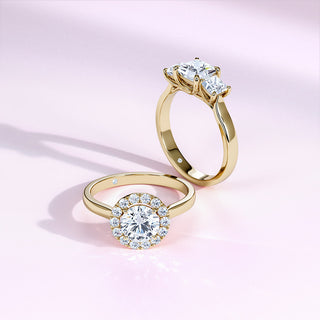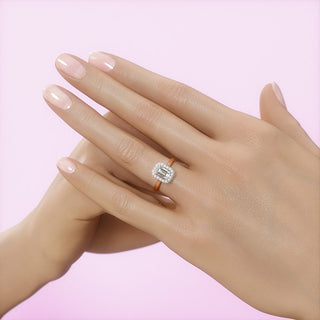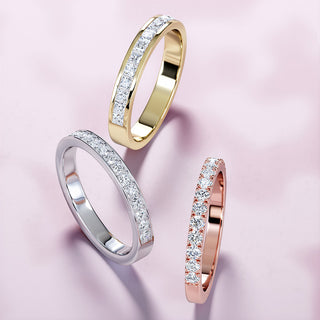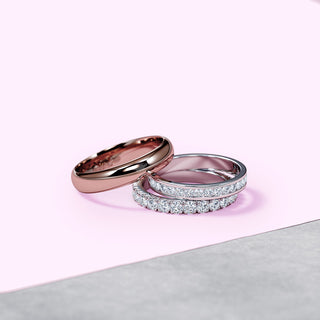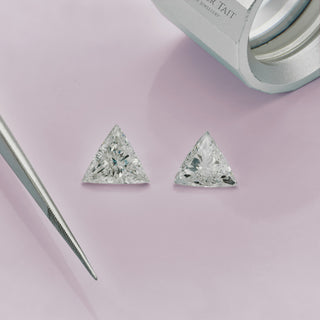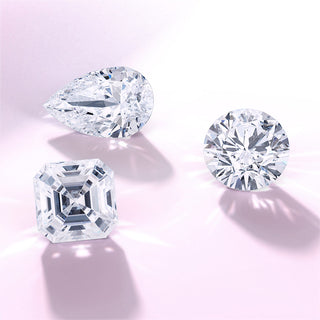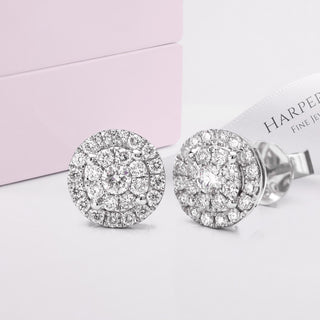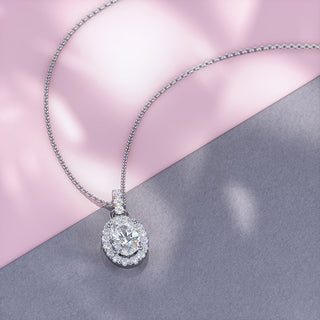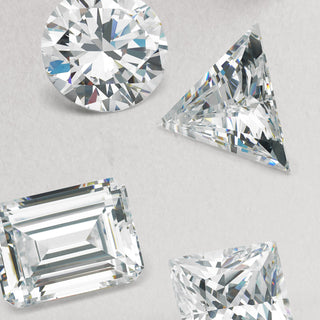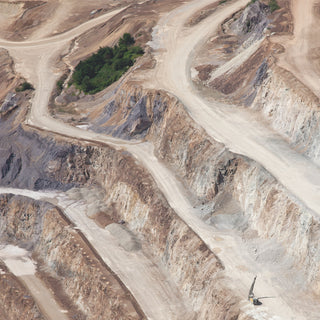Of all the 4Cs, carat is perhaps the most familiar. Carat is a specific unit of measurement unique to gemstones, measuring not the size of a stone but its weight.
In this guide, we’ll break down what carat weight means, how it’s measured and why bigger isn’t necessarily better when it comes to choosing your perfect diamond.
What is diamond carat weight?
Carat is the unit of weight used for diamonds. Although there is a correlation with grams, gemstones are only ever weighed in carats. One carat is equal to 0.2 grams and each carat is divided into 100 points, allowing for very precise (and small) measurements. A 0.75-carat diamond is 75 points, for instance. A very small melee stone - such as that found in a delicate halo or diamond-set band - might weigh less than 0.01ct.
Carat weight is often one of the most discussed aspects when selecting a diamond. Many people know from the very start of the process they want a ‘half carat’ or ‘one carat’ stone. But carat is not the only factor contributing to a diamond’s beauty or appearance.

Diamond carat weight vs. size
Although carat weight affects the size of the diamond, it doesn’t provide the full picture. As carat is a measure of weight, diamonds of similar carat weights might have different dimensions depending on how they have been cut.
If cut to ideal proportions, a 1.00ct round brilliant cut diamond will measure about 6.5mm. If the cut is shallow or deep, however, the 'spread' of the diamond (how large it appears) will be smaller or larger than the carat weight suggests.
Different diamond shapes will also vary wildly in size across the same carat weight. A 1.00ct princess cut diamond measures around 6mm, while a 1.00ct marquise diamond will be around 10mm long. It all comes down to how the weight is distributed.
Key carat weights - and prices
Thanks to demand, when diamonds hit specific carat milestones such as 0.50ct ('half carat'), 1.00ct or 2.00ct, prices often jump.
Now, it is perfectly natural to want a key carat weight - we create a lot of beautiful one-carat rings for our couples! However, we also know all about wedding budgets, and it is always worth being aware of your options.
In theory, a diamond just under a key weight, for example 0.98ct, would appear nearly identical in size to a 1.00ct diamond but be cheaper. In practice such carat weights are relatively rare, with rough diamonds carefully cut to maximise weight. However considering a slightly lower carat weight might offer value for budget without too great a visual difference.
A 0.85ct stone, for instance, will be only around 0.5mm smaller than a 1.00ct stone (6.0mm to 6.5mm) but come in at a noticeably lower price point.
How to choose the right diamond carat weight for you?
Carat weight is a very personal decision. Some people love the look of a large, statement diamond, while others are drawn to subtle and understated sparkle. Some lifestyles don't lend themselves to very large stones. If you lead an active lifestyle, a very large diamond might not be the most practical option.
Consider first what will make you feel excited and comfortable to have on your finger. You, after all, will be the one wearing your ring every day and for years to come!
It is also important to consider carat weight and size in relation to the other 4Cs. While larger diamonds look striking, they also reveal imperfections in colour and clarity more easily.
Here at Harper Tait, we sometimes see couples tempted to prioritise size over other factors, but the larger you go the more you actually have to consider other characteristics.
We always advise balancing carat weight with cut, colour, and clarity. A smaller, high-quality stone can sometimes have a greater impact than a larger, lower-quality one.
Making a smaller diamond look larger
If your budget doesn't stretch to the carat weight of your dreams, fear not! We have some ideas. There are multiple ways to enhance the appearance of a smaller diamond, creating the illusion of more carat weight.
-
Halo settings: Surrounding the centre stone with a halo of smaller diamonds, a halo - such as in our Windsor ring - adds extra spread and sparkle. Our Highgrove ring even adds a diamond-set split shank for a hugely luxury look, whatever your centre size.
-
Pavé bands: If you don’t want a halo, choosing a pavé-set diamond band adds brilliance to your entire ring. With six pretty claws and a sparkling shank, our Jubilee ring makes even a small centre stone part of a luxurious and sophisticated piece.
-
Rubover settings: With polished metal embracing diamond, sleek and modern rubover settings - particularly in platinum or white gold - create an illusion of a subtler larger stone.
-
Fancy shapes: An elongated shape such as a marquise or oval will give more visual spread for the same carat weight, and may also offer better value than the more popular (and therefore comparatively costlier) round brilliant cut. Just look at our striking Whitehall marquise ring.
Engagement ring styles for different carat weights
While there are never any 'hard and fast' rules when it comes to your engagement ring, certain engagement ring styles lend themselves to particular carat weights.
Small and medium stones (0.50ct and under) work beautifully in delicate solitaires like our Kensington or in pieces where the band is as much a part of the design as the diamond, such as our Brompton. A halo or diamond set band will make any smaller stone look spectacular, while hidden diamond detail - like on our Claridge ring emphasises the delicacy.
Larger stones (0.60ct – 1.00ct) allow you to make a real statement in halo or three-stone rings, such as our Fitzrovia or Hamstead. Almost any solitaire will look fantastic in this size, so you’re spoilt for choice!
Very large stones (1.50ct+) suit a classic solitaire such as our four claw Knightsbridge, where the simple design and substantial band lets the stone do all the talking! If you want your stone to feel even more secure, choose a six claw ring like our Hamley.
Our take on size
When budget allows, a high carat weight diamond in our signature D-F/VS - VVS quality is undeniably stunning. But big doesn't always mean better - it's vital to consider carat weight as part of a package, with clarity, cut and colour playing equally vital roles.
Here at Harper Tait, we are seeing more people balancing their budget with a smaller but higher-quality diamond. A well-cut diamond in a great quality and clarity will always look beautiful, whatever the size.
Our goal is to help you find a diamond that fits your personal style, lifestyle and budget. Whether you prefer subtle sparkle or a serious statement, we will work with you to find the perfect balance.
Diamond Carat FAQs
How does diamond carat weight affect price?
Significantly! Diamonds are priced by carat, with the cost increasing as the weight goes up. Additionally, due to their rarity, larger stones have a higher price per carat than smaller ones. A single stone of 1.00ct will be more expensive than a set of ten stones totalling 1.00ct. That's why it can be cheaper to choose a ring with a 'total carat weight' made up with melee diamonds. For instance, an 0.80ct centre stone with 0.20ct of small diamonds in a halo will cost less than a 1.00ct solitaire.
Diamonds hit key price thresholds at popular sizes like 0.50ct, 1.00ct, and 2.00ct, and there are generally sharp price jumps at these milestones.
Does bigger mean better?
Not always - there are, after all, four Cs and not just one! While a larger carat weight stone can make a statement, cut, clarity and colour all impact its beauty and brilliance. In fact, the larger a stone the more you need to consider the other factors.
How can I tell what a carat weight will look like?
If you’re curious about how a specific carat weight will look on your finger, we recommend taking a look at our carat weight chart above. This tool gives a helpful guide to compare average mm sizes of different carat weights across various diamond shapes. Better yet, come and visit us in our Hatton Garden showroom, where you can see and try on diamonds in person! If you’re not local, you can book a virtual consultation where we’ll guide you through the options.
Can I make a smaller carat weight look larger?
There are many design choices that can maximise the ‘show’ you get for your carat weight, from choosing an elongated stone to adding a halo. Feel free to contact us and we'll let you into all our secrets...!
Download our carat size chart here as an indication of diamond carat size.


